The iPad Air Review
by Anand Lal Shimpi on October 29, 2013 9:00 PM ESTGPU Performance
Since the iPad Air uses the same A7 silicon as the iPhone 5s, it also uses the same on-die GPU as the 5s: IMG’s PowerVR G6430. This is a 4-cluster configuration of IMG’s latest graphics hardware, running at some relatively high frequency. I already went into some detail on the G6430 in our 5s review so I won’t rehash that here, but we’re basically looking at a shift to a more efficient scalar architecture.
I still don’t have confirmations of clock speeds, but I believe we’re looking at a max GPU clock of around 450MHz. As you’ll see from the results below, there’s a small difference in performance between the iPad Air and iPhone 5s in terms of peak GPU performance - implying very similar clocks. The difference is the iPad Air should be able to sustain its max frequency longer than the iPhone 5s can.
| Mobile SoC GPU Comparison | ||||||||||||
| PowerVR SGX 554MP4 | PowerVR G6430 | PowerVR G6430 | ||||||||||
| Used In | iPad 4 | iPhone 5s | iPad Air | |||||||||
| SIMD Name | USSE2 | USC | USC | |||||||||
| # of SIMDs | 32 | 4 | 4 | |||||||||
| MADs per SIMD | 4 | 32 | 32 | |||||||||
| Total MADs | 128 | 128 | 128 | |||||||||
| GFLOPS @ 300MHz | 76.8 GFLOPS | 76.8 GFLOPS | 76.8 GFLOPS | |||||||||
| GFLOPS as Shipping | 68.1 GFLOPS (?) | 115.2 GFLOPS | 115.2 GFLOPS | |||||||||
Since we’re talking about an A7 here and not an X-series SoC, there’s still only a 64-bit wide memory interface. As memory bandwidth is a key enabler of GPU performance I was curious to see how GPU performance compared to the outgoing iPad 4 with its much wider memory interface. Do keep in mind that the A7 does include a large system cache on-die, which can help improve effective memory bandwidth.
GFXBench 2.7
We'll start our GPU performance analysis with a look at low level results using GFXBench/GLBenchmark 2.7. The low level tests, particularly the offscreen ones, should give us some idea as to whether or not there's any increase in GPU frequency for the iPad Air vs. iPhone 5s implementations of A7.
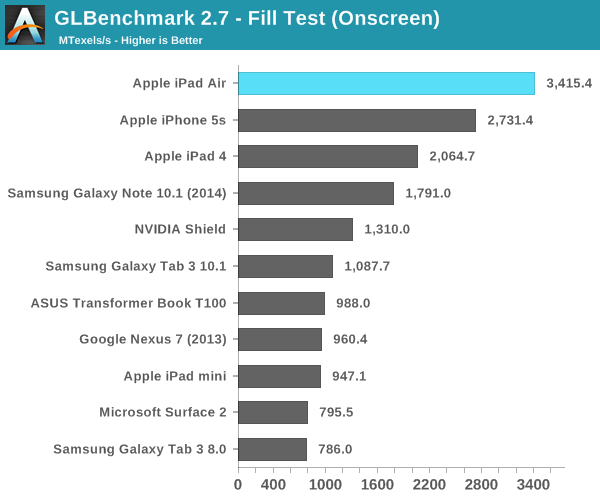
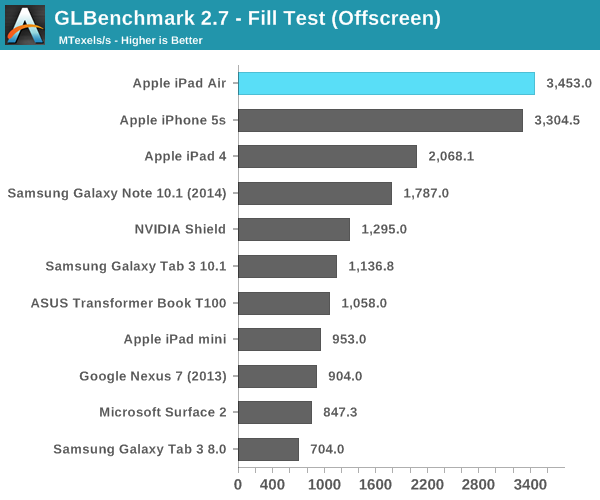
Looking at the fill rate results, there's a 4.5% increase in performance compared to the iPhone 5s. That could be the magnitude of clock increase that we're seeing between A7s. Apple could very well be relying on more thermal headroom in the iPad Air to provide any real world GPU performance advantages over the iPhone 5s.
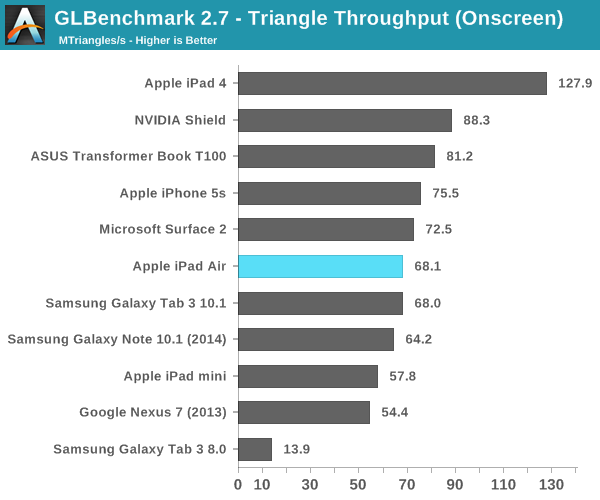

We see an even smaller gap between the Air and 5s in the triangle throughput tests (2.9%). There doesn't seem to be any substantial difference in GPU frequency between A7 implementations here. The regression in triangle rate performance compared to the iPad 4 is explained by differences in how Series 6 and Series 5XT GPUs scale in width. Whereas 5XT replicated nearly the entire GPU for "multi-core" versions, multi-cluster versions of Rogue only replicate at the shader array. The result? We don't see the same sort of peak triangle setup scaling we did back on multi-core 5XT parts. I'm not sure I'm particularly happy with the magnitude of the regression here, but I haven't seen any real world cases where it matters yet.
Next up are the game simulation tests. We'll start with the more strenuous of the two: T-Rex HD.
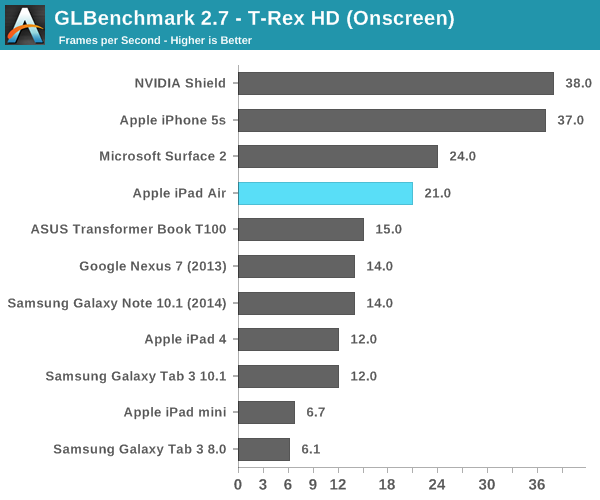
Here we get closer to Apple's claims of a 2x increase in performance. The iPad Air delivers 75% more performance than the iPad 4 in this test. Once again the iPhone 5s pulls ahead but that's because the onscreen tests render at display resolution, which is lower on the 5s.
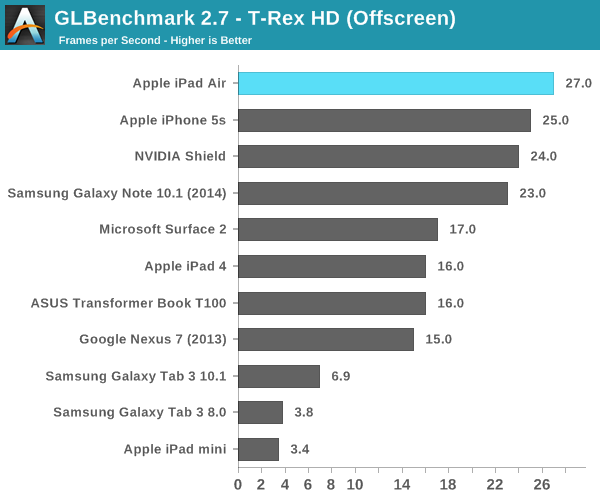
Offscreen performance sees similar scaling: ~69% better performance compared to the iPad 4.
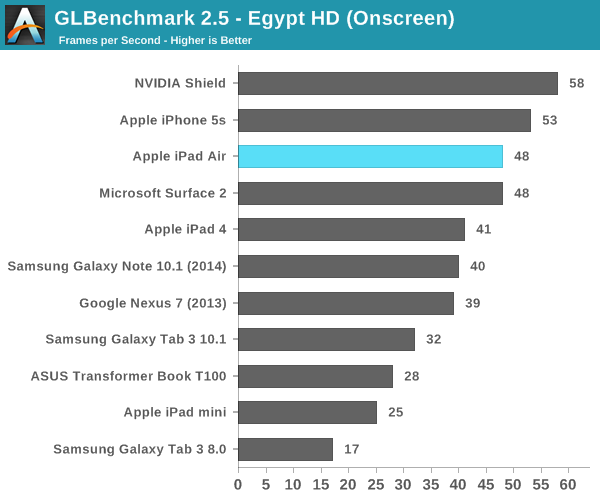
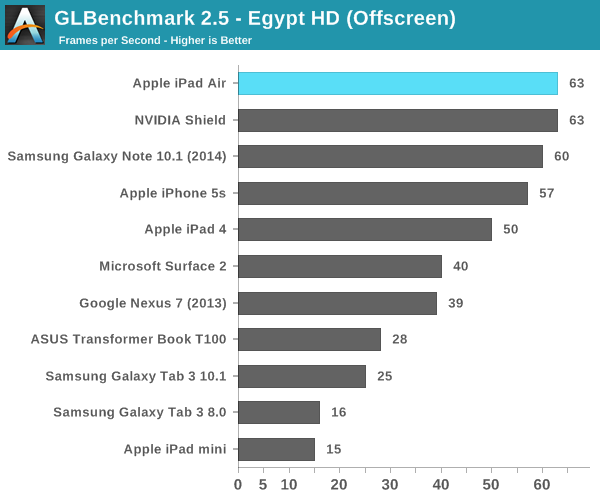
3DMark
We're once again running 3DMark's newest Unlimited mode which does its best to run independently of v-sync and at a standard resolution across all devices. I've also included 3DMark Extreme results below that feature a few more comparison points.
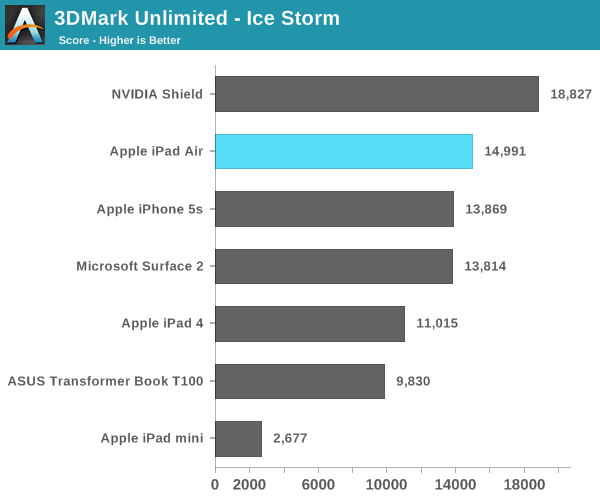
The overall Ice Storm scores show a 36% improvement in performance over the iPad 4 and an 8% increase compared to the iPhone 5s. Given the CPU frequency advantage of the A7 in the Air vs. the iPhone 5s, I'm guessing that's why we're seeing the performance gap we are here.
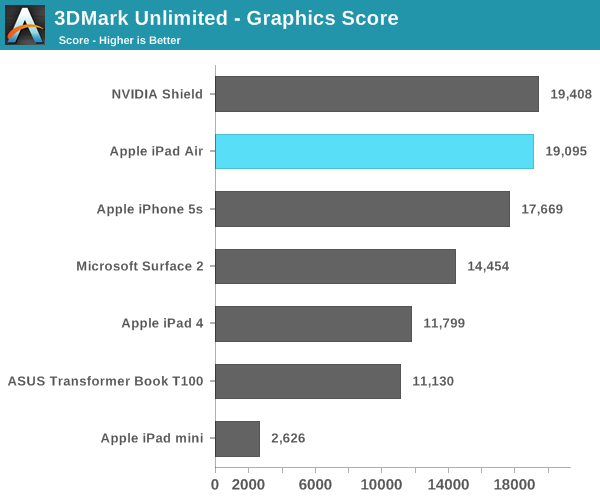
If we focus exclusively on the GPU tests (which themselves are still CPU bound), the iPad Air's performance advantage over the iPad 4 grows to over 60%.
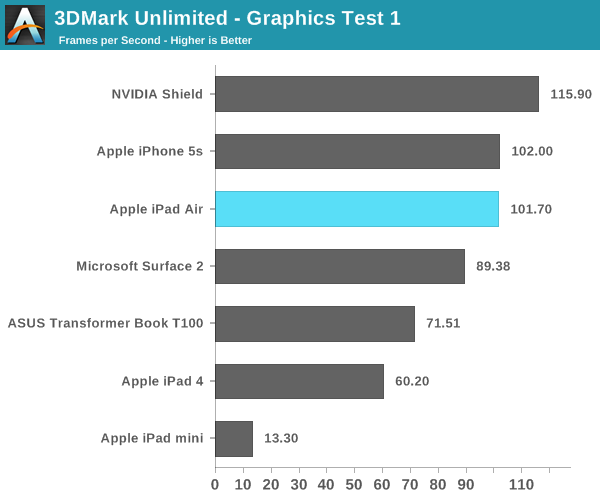
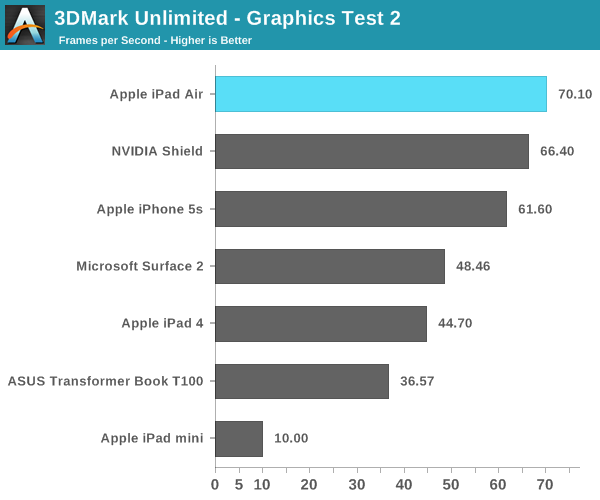
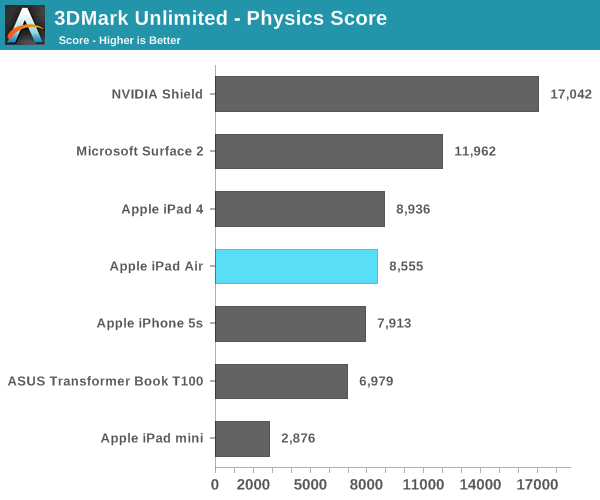
I'm still not entirely sure what's going on with the 3DMark Physics test, but we've seen this two reviews in a row now where Cyclone showed no performance increase at all compared to Swift despite this being largely a CPU test.
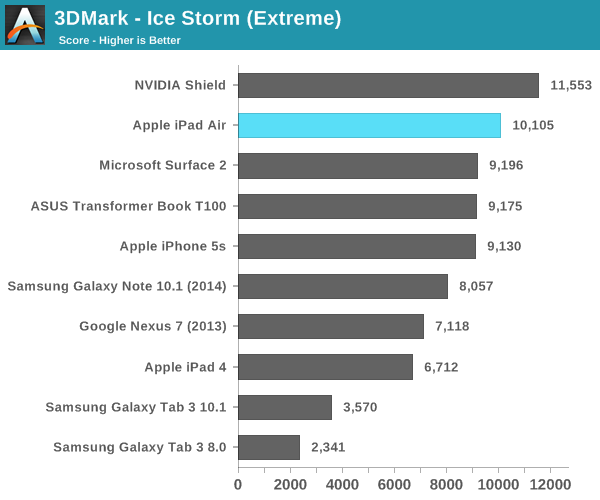
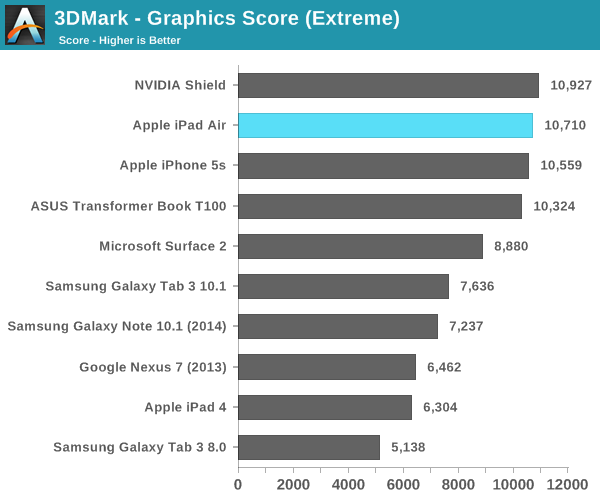
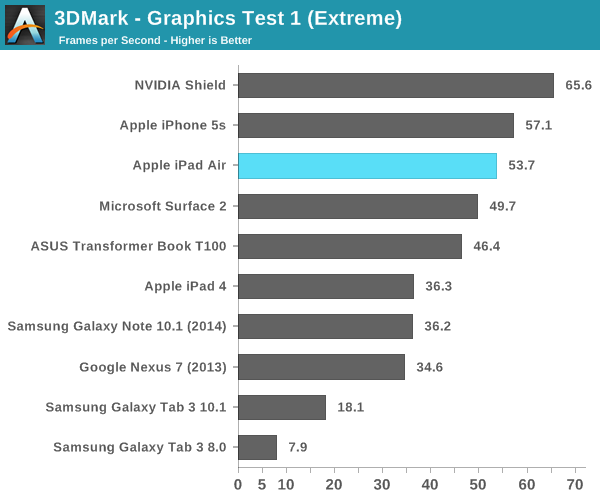
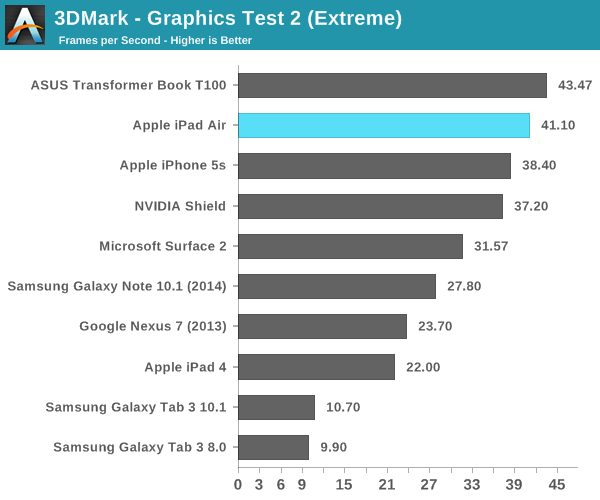

Basemark X
Basemark X is a new addition to our mobile GPU benchmark suite. There are no low level tests here, just some game simulation tests run at both onscreen (device resolution) and offscreen (1080p, no vsync) settings. The scene complexity is far closer to GLBenchmark 2.7 than the new 3DMark Ice Storm benchmark, so frame rates are pretty low.
I'm still having random issues with Basemark X reliably running both on and offscreen tests on iOS 7. Unfortunately I could only get onscreen results for the iPad Air, which came in at 46% faster than the iPad 4. Note the iPad mini and iPhone 5s benefit from having lower native resolutions here, which is why they perform so well.
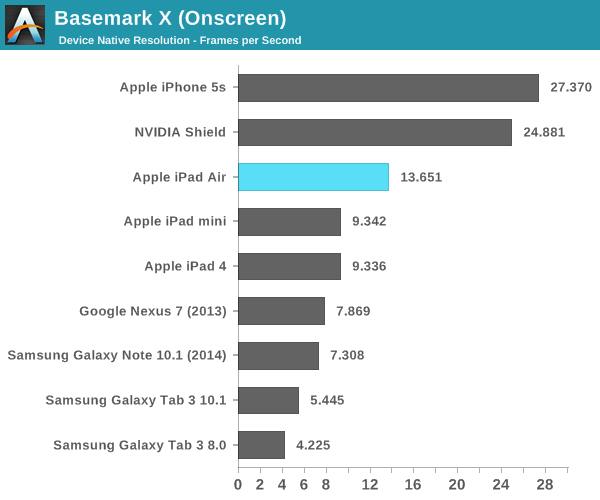










444 Comments
View All Comments
AldenG - Wednesday, October 30, 2013 - link
Not including the Kindle Fire HDX in the comparison does seem to be a glaring oversight as other sites have posted benchmarks that show it is roughly 2x the power of the Nexus 7. I actually read this review trying to decide between them, and this makes it really hard. As an iPad owner AND Amazon Prime subscriber, I'm on the fence, and was hoping this review would tip the balance. Anand, please update with Kindle specs, too.coolhardware - Wednesday, October 30, 2013 - link
It is pretty crazy that the tablet line that introduced the 'retina' moniker is not in the top 10 anymore in pixel density:http://pixensity.com/list/tablet/
I understand many people say pixel density beyond Apple's dictated/calculated points is irrelevant, but from a technical standpoint it is really cool to see these other ultra high res displays out there :-)
Regardless, Apple does make nice tablets and I do plan on replacing my wife's iPad 3 with an iPad Air (mainly since her iPad 3 has been laggy since upgrading to iOS 7).
ssiu - Wednesday, October 30, 2013 - link
The 7" Kindle Fire HDX is not in the list (should be #3 at 323 PPI)coolhardware - Wednesday, October 30, 2013 - link
Good call! You can submit a device here: http://pixensity.com/add/Along those same lines of new tablets, I am excited to see the new HDX 8.9 and the new Nexus 10 (maybe Nov 5th?)
choch0 - Wednesday, October 30, 2013 - link
does anyone know where Anand got the colored triangle wallpaper he used on his ipad air for the review photos? i love the wallpaper! any help/feedback would be greatly appreciated.Commodus - Wednesday, October 30, 2013 - link
That's actually built into iOS 7 (not the default).deathBOB - Wednesday, October 30, 2013 - link
Anand, what has changed to drop display power usage?lilo777 - Wednesday, October 30, 2013 - link
"You can see the 5s throttles back its CPU frequency to about 1GHz after the 2 minute mark. The crazy thing is that until that point the 5s manages to run at full frequency without so much as a hiccup for two full minutes, running an incredibly power hungry task. Given that most iOS apps aren’t this power intensive for such a sustained period of time, iPhone 5s users should almost always see the A7 running at a full 1.3GHz. Pretty crazy."Also crazy is the fact that somehow Anand decided not to call this benchmark cheating unlike what he did with Android tests.
carbonsx - Wednesday, October 30, 2013 - link
"Also crazy is the fact that somehow Anand decided not to call this benchmark cheating unlike what he did with Android tests."Isn't it though... There is no way that the A7 will always be running at a full 1.3GHz for thermal and battery life reasons, other than during a benchmark. This statement makes absolutely no sense:
"Given that most iOS apps aren’t this power intensive for such a sustained period of time, iPhone 5s users should almost always see the A7 running at a full 1.3GHz. Pretty crazy."
Pretty crazy indeed.
tgibbs - Wednesday, October 30, 2013 - link
Benchmark cheating is not the processor throttling down when driven hard for a period of time--in fact, it is the exact opposite. Benchmark cheating is the device recognizing a benchmarking app and entering a special mode where it does *not* throttle down--even though it would do so if any other app were hitting the processor that hard.